If at the site it is necessary to plant a low decorative plant, which will become a lively hedge or create a cozy shady corner - you should pay attention to the Ginnal Maple.
Maple Ginnal - a low tree or a sprawling shrub with a short barrel and a beautiful wide crown, widely used for landscaping gardening zones. Landscape designers have long fallen in love with an unpretentious perennial plant, which is truly transformed into the autumn period. Then his foliage becomes carminno - red shades, fascinating the surrounding violence and the variety of paints. How to grow Maple Ginnala yourself? What care is needed by culture? How does the plant breed? Read the detailed information in this selection of material.
Maple Ginnal, Plant Description
- Maple Ginnal, also called Maple Screchny, refers to the genus Maple from the Sapind family family.
- Maple Ginnal is a small deciduous tree, widely used in the field of landscape design and decorative gardening. In addition to trees, large shrub shapes of Maple Ginnala are often found.
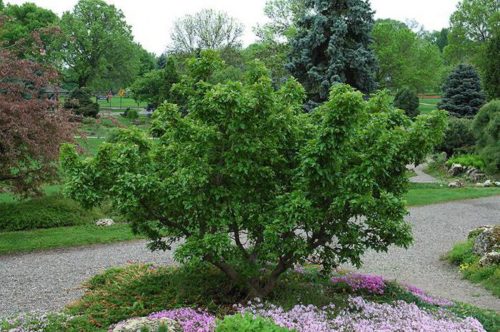
- The height of the Ginnala Maple varies from 3 to 9 meters. Annual shooting of shoots is considered moderate and amounts to about 20-40 cm. Perennial trunk is short and thin, about 30 cm in diameter.
- The thin bark of the village has a gray brown tint and a smooth structure. Adult copies are highlighted slightly cracking bark and the darker shade.
- Branches - thin, straight, brown, thick fruitful. The leaves of the Maple Ginnal, like the whole, beautiful, palpatible cut, shape. As a rule, they are 3 bladed, with a more elongated central share. Straight leaf sticks, with a pinkish tint.
- Glossy maple leaves by autumn change their painting with green on yellow, orange and bright red. It is thanks to bright shades of foliage during this period, a perennial looks very elegant and effectively. An important role on the intensity of the painting of the Klenk krona plays the illumination of the site: the better and more light - the brighter there will be the color of the leaves.
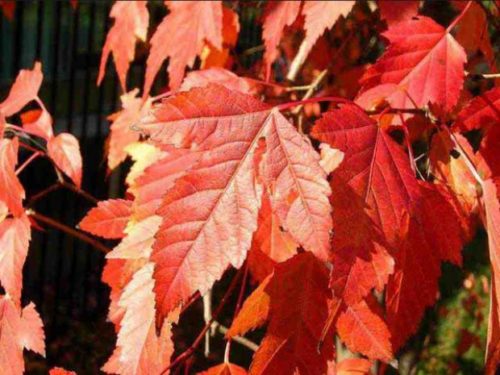
- Krona Klena is wide, spread, tolten or cone-shaped. On average, the diameter of the crown of an adult plant reaches about 5 meters.
- The bloom of maple comes in spring, immediately after the dissolution of the first leaves. Duration of flowering 2-3 weeks. Greenish yellow fragrant flowers are collected in thick multi-flowered inflorescences brush.
- Flower, the plant gradually forms fruits - paired clips, fully ripening by autumn, when and spread by the wind. First, the winters are painted in red, but, as ripening, the fruits acquire a brown tint.
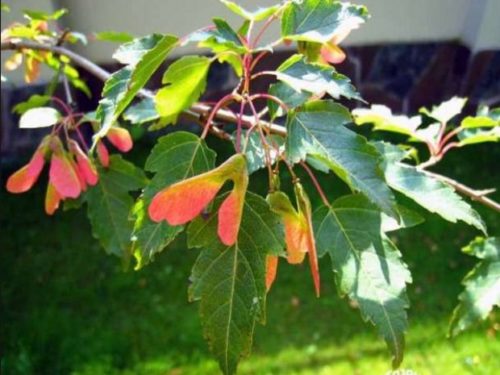
- The root system of the tree (or shrub) is superficial - branched. Thanks to thick roots, the plant "is not afraid" of the gusty winds or drafts.
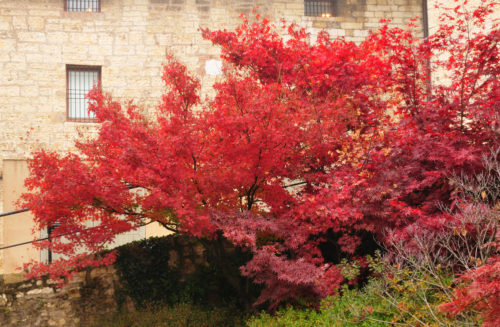
Maple Ginnal, cultural features
- In nature, the view grows in Mongolia, Korea, Siberia and Japan. Most often, the plant can be found in the river valleys or near any reservoirs. Hence the second name of the species - Maple Screchny.
- In Russia, the perennial began to cultivate in the second half of the 19th century. Currently, maple is spread throughout the country.
- Maple Ginnal is either a small compact church with one, pronounced trunk, or an empty multisage shrub.
- Maple Screchny is considered one of the most cold-resistant species of maples, referring to the 2nd zone of frost resistance. High winter hardiness Maple Ginnal allows him to grow it in most regions of the country, including in zones with harsh climatic conditions.
- In addition to high frost-resistant qualities, Maple Ginnal moves great or windy weather, easily and quickly adapts to urban growth conditions.
- Maple Ginnal is a long-liver and can grow in one place from 100 to 250 years.
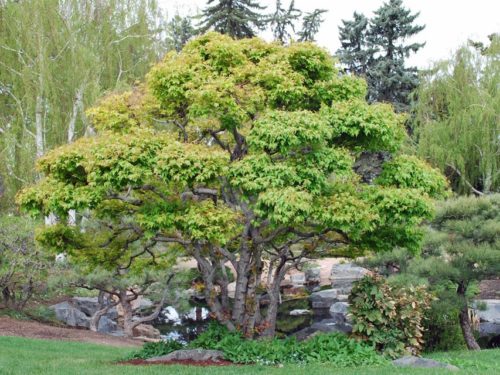
Maple Screchny and Maple Tatar: similarities and differences
Very often, the Maple is a launching guinnal confused with his close "birth" - Maple Tatar. And indeed, these close-friendly plants have not only common morphological signs, some botany even classify them as one appearance. Plants are similar in general habit, crown architecture, care conditions and applications. But, nevertheless, there are some differences in which these plants can be identified.
- Maple Tatar and Maple Ginnal are distinguished by the appearance of the leaves: the maple of the stringy they are brilliant and distinctly cut, and in the Tatar view - matte, without pronounced blades.
- In addition to leaves, these types of maple have a different area of \u200b\u200borigin, which affected the ecology of their cultivation. Maple Tatarsky refers to the European group of plants, while the maple is curved to the Asian group of trees.
- Under favorable conditions and proper care, the maple is transformed into the autumn period and earlier green, the mass becomes a flame-red magnificent "cap". Unlike Ginnala, the Tatar view of the maple looks less elegant and spectacular: the fall of its leaves acquire yellow color, and only in rare cases - slightly pinkish shades.
Thus, Maple Screchny and Maple Tatar is two similar types of single Sapind family family from the general kind of "Maple".
Maple Ginnal, where and how to buy?
- Maple Screchny (Ginnala) can be purchased in specialized nurseries, "proven" online stores, on thematic exhibitions and sales or garden shops. In addition, experts consultants always competently and qualifying about the features of planting and leaving the plant.
- It is best to buy 2-year-old seedlings with a closed root system. When examining a seedling, you should pay attention to its appearance. A healthy plant does not have obvious defects, damage or signs of wilting. In the case of buying a maple with an open root system, it is necessary to carefully consider its roots. The roots of a healthy seedling are well developed, without rot, growths or any damage.
- The price of the Ginnal maple depends on the set of factors: the size of a seedling, the sale region and directly marketing "policies" of the outlet. So, some nurseries exhibit the average cost of one copy of 2000 to 6,000 rubles, while it is important to specify the presence of the plant and the relevance of the price today.
- According to customer reviews, the following varieties of Maple Ginnala are most popular: "Albovariegatum" (distinguished by white leaves segments), "Durand Dwarf" (dwarfish strongly branched shape of a maple with small leaves), "Pulvelerulentum" (characterized by leaf with white splashes).
Maple Ginnal, landing features
To make a maple quickly and "gained" a green mass, it is important to accommodately approach the planting seedling process: competently and for many years to choose a place for a long-term long-lived and right, from an agrotechnical point of view, plant a young plant.
Maple Ginnal, place for landing
- Light-lubricate, dough and wind-resistant plant, maple, it is worth landing on outdoor solar plots. Moreover, the illumination directly affects the saturation of the color and the decorative properties of autumn foliage of perennial. If this "moment" is not so important, the maple will grow perfectly in half, but, alas, without bright red shades in the autumn period.
- The soil composition for maple is not so important, although there are certain preferences. Maple Ginnala develops well on nutrient, lightweight soils, with neutral or weakly acidic reaction, where pH 6-7.5. With high ground latching, to resolve the level of acidity, the peat will be required.
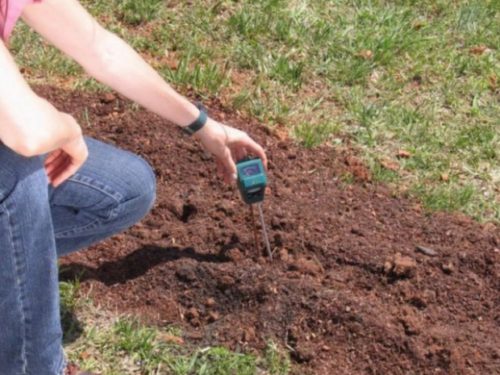
- The plant does not make saline sites, the fertile nourishing ground is beneficial.
- Heavy tight soil will negatively affect the development of culture, so river sand or sawdust is added to it.
- Planting the seedlings of Maple Ginnal is carried out in spring or autumn.
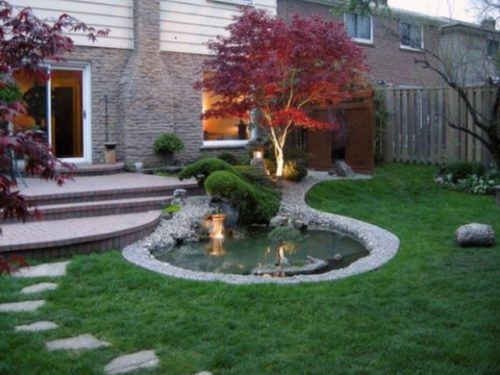
Maple Ginnal, Agrotechnical landing
- The sizes of the landing point depend on the size of the seedling and usually constitute about half a meter in all respects. Pre-present preparation begins 2-3 weeks before planting a plant and includes: thorough loosening of the bottom of the landing pit for pods, making organic or mineral fertilizers.
- At the bottom of the landing pit, the mixture mixed with the soil and consisting of humus, sand and leaf (sod) land, in a ratio of 3: 1: 2. Alternative to humidiation can serve peat compost. Adding a small amount of superphosphate fertilizer will only improve the nutrition and subsequent development of the maple seedling. Approximate norm - 100 g of fertilizer per 1 m 2 Soil.
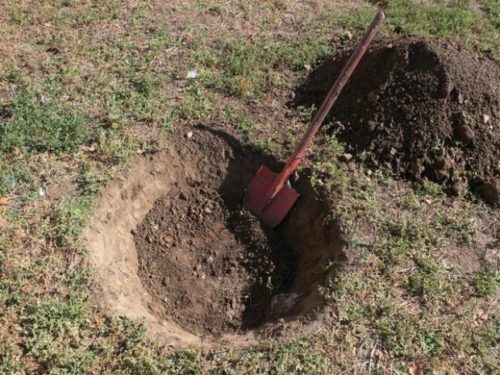
- If landing is planned by the hodges of the Ginnal maple - a trench is prepared, a depth, at least 50 cm and a length, respectively, the dimensions of the planned hedge.
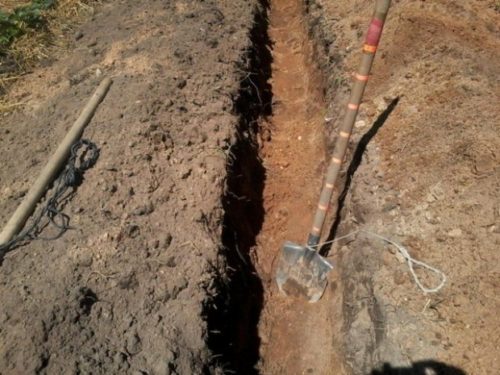
- Before boarding, an approximate occurrence of groundwater should be studied. If water is close to the surface (or the site is located in the wetlands) - can not do without drainage preparation. For laying a drainage layer, crushed stone, broken brick (large sand) or crushed slate. In the case of preparation of the drainage layer, the depth of the landing pit (or trenches) is increased by 20-30 cm.
- Sequence of layers in the landing pit: First, the drainage layer on which the layer of the soil mixture is poured.
- A seedlove is put in the pit, grow roots and fall asleep with soil, periodically tamping it so that "emptiness" is not formed. The root cervix should be at the soil level or slightly (up to 5 cm) to delve into the ground.
- With group landings (for the formation of the hedge), the distance between the seedlings is approximately 1-2 meters. Single landing involves the distance between the trees is twice as bigge.
- After landing, the maple is abundantly watered with water, and the rolling circle of a seedling is mounted peat, cheese or sawdust. A layer of mulch at 5-10 cm allows longer to keep the wet microclimate, avoid the appearance of weed grass and protect the roots from freezing in the winter.
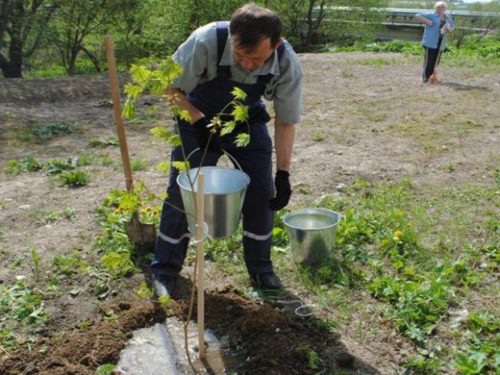
Maple Ginnala, plant care
After landing, maple is growing rapidly and develops in a new place. The plant is absolutely not demanding about special care, it will take it only periodic watering, the loosening of the priority circle, feeding the soil and haircut of the crown. The usual agrotechnical events will be allowed to admire the chic crown of Maple Ginnala.
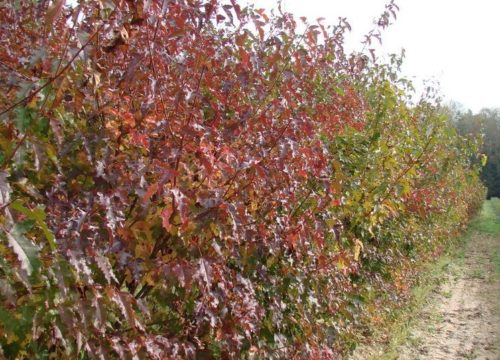
Watering, loosening and mulching Maple Ginnala
- Watering an adult plant is not often - 1 time per month, it will take about 15-20 liters of water under the bush. The irrigation rate increases only in a period of long drought, then the maple is watered 1 time per week.
- In frequent and regular irrigation, the plant needs immediately after landing, when the seedlock is still young and faster.
- A sufficient level of irrigation impregnates the land about half a meter deep.
- After watering, the site around the plant must be exploded. Loose the soil follows a shallow (by 5-6 cm) so as not to damage the surface root system of perennial.
- In the event of the appearance of weed herbs, the bed is stolen.
- The optimal option for the care of the Ginnal Maple will be the mulching of the priority circle of the plant immediately after it is landing. A small layer (up to 5 cm) peat or wood sawdust is suitable as a mulch.
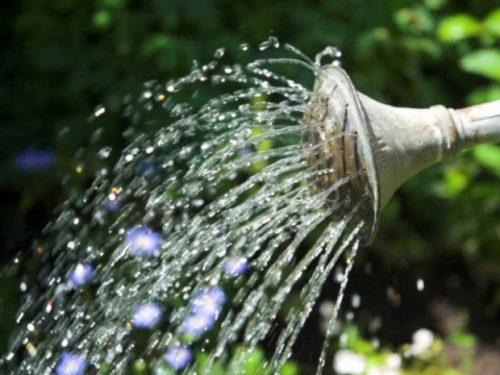
Making fertilizers and feeding Maple Ginnala
- If, when planting, mineral fertilizers were not introduced into the ground, one year later, the plant should be filled. For this, urea is used (30-40 g per 1m 2), potash salt (15-20 g per 1m 2) or superphosphate (30-45 g N1M 2).
- In the summer, Maple Ginnala feed the complex fertilizer. You can use, for example, the complex "Kemira-Universal", at the rate of 100 g of fertilizer on 1m 2 Plot.
- In the fall, under the steamer, well focus on the area with an organica (humus, compost).
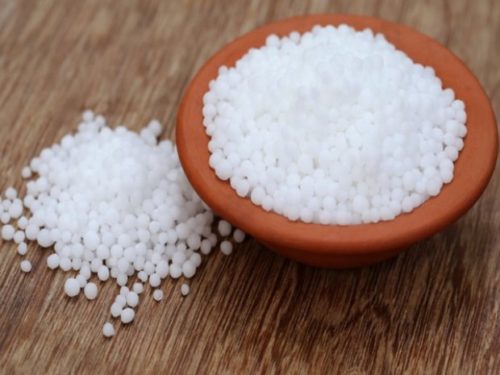
Crane trim Ginnala
- Early spring (before the awakening of the kidneys), in the first year after the landing of the maple, begin to carry out its first pruning. Subsequently, the haircut is carried out every year (on the planned pattern).
- You can cut the maple of the Ginnal and in the fall, just to do it approximately 1-1.5 months before the onset of winter cold.
- Maple Ginnal freezes the trimming without any problems, quickly restored and activates a new shoot of shoots (30-40 cm per season).
- When trimming should be left about 10 cm of young shoots, until the desired height of the maple is achieved. If maples are planted as a border or alive hedge, the crown cutter is carried out regularly, as shoots are growing. Often, the height of shrubs leaves no more than half a meter. For the formation of such low rods-borders apply an inclined shrub haircut so that the plant is not too bare down.
- In addition to forming trimming (to create the desired crown shape), spring sanitary pruning is carried out annually. At the same time, dry, broken or frozen over the winter branches are removed.
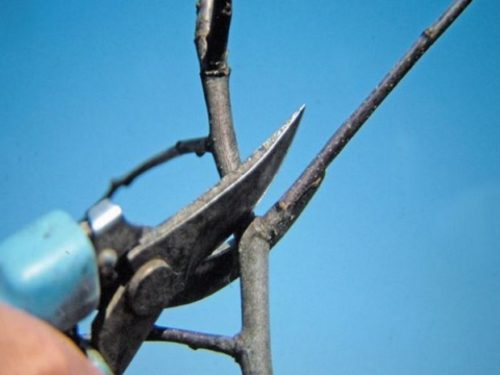
Shelter for the winter of Maple Ginnala
- Adult plant, Klen Ginnal, is distinguished by a high level of frost resistance, so in a special shelter for the winter does not need.
- Exceptions are young rapid maple seedlings (especially stammerous cultures), which are covered with leaves or sweets for the winter, and the trunk is wrapped with burlap. The main thing is to cover the root neck, the roots and the place of the Stamma "Young", especially in the honesty cold winters. As "mature", after 2-3 years, Maple will no longer need a similar procedure.
Diseases and pests Maple Ginnala
- Maple Ginnal is resistant to most diseases and is rarely subjected to pest attacks.
- Of the disease, maple may be affected by the so-called. Coral spot, when bright red spots appear on the plant's crust. At the same time, patients are cut off, the sections of the sections are treated with a garden harder, and all the plant is sprayed with a solution of copper sulfate.
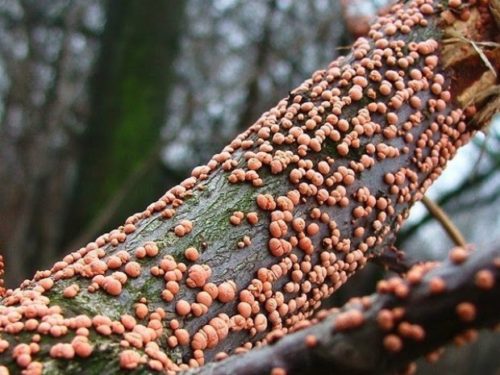
- If the foliage appears on the foliage - the plant "infected" with mildew. It happens more often in a summer arid period. In this case, the processing of green mass with a solution of sulfur hammer with lime taken in the proportion of 2: 1.
- As for pests, Maple Ginnal can damage some insects: whitefly, leaf weevil, torment Cherver. In the fight against pests, appropriate insecticides will be useful: "Aktellik", "Aktara", "AMOFOS", "Nitrafen", "Carbofos", "Chlorofos".

- The preventive measure that prevents the appearance and spread of insects is the cleaning of fallen leaves from the site, trimming of damaged and patients of shoots, a single treatment of the maple trees with a carbonic solution.
Ginnala maple reproduction
Maple reproduction is possible in several ways: seeds, cuttings and vaccination (for decorative forms). Each method has its advantages and disadvantages.
- In the natural medium, the maple seeds of the winners are subjected to winter stratification, after which they successfully germinate in the warm season. Therefore, if the plant independently reproduce the plant in this way, it is important to make an artificial stratification of seed material. Seed hardened lasts a few months (2-4) at a temperature not higher than 5-7 0S. Maple Seeds retain the germination of no more than 2 years. Before sowing, seeds are additionally soaked for 2-3 days in hydrogen peroxide. This technique allows you to stimulate seed germination. In the end of the spring, the latched seeds planted on the site, closeing in the ground by 3-4 cm. Slow seeds in soil from humus, sand and turf (as well as seedlings). After about 3 weeks, seedlings appear, which are rapidly growing and reaching about 30-40 cm. Care for seedlings includes watering, weeding, loosening and, in the case of strong heat, shading. After 2-3 years, the seedlings will be ready for a transplant to a permanent place.
- For reproduction, cuttings are harvested, about 20-25 cm long. Cuttings for the winter are cheered into the ground, and in the spring it is planted into individual deep tanks for rooting. The soil substrate for cuttings use nutritive light soil.
- The decorative forms of the maple breed the eyepiece (by the advent of the kidney) or kopulove (grafting with a stalk). The reproduction of the vaccination is carried out in early spring, prior to the start of active inactivity. The height of the strain can be from 50 cm to 3 m.
Maple Ginnal, Application Scope
- The most important destination of Maple Ginnala is decorative. A low church or an empty shrub with a beautiful tent-like crown looks spectacular throughout the vegetative period. In the summer, Maple Ginnala "gives" a thick shadow with his green "hat" of foliage, and in the fall draws attention to those surrounding bright fiery paints. Bright red carmine shades of autumn foliage maple are impressive with their saturation and unusualness against the background of traditionally yellow tones of surrounding vegetation.
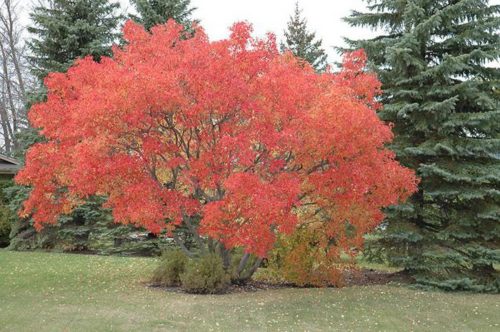
- Maple Ginnal is planted as a single focus in the garden and in the form of group landings forming very picturesque borders and alive hedges. The height of the hedge formed by the landings of the Ginnal can vary in its taste: from a high wall under 2-3 m, to dense low borders with a height of 50 cm. It is natural that in the latter case, in order to keep the neat initial type of bleeding with a dense mosaic of leaves, you will need several Stregging per season.
- Compositions with the Maple Ginnal in the garden, in the park or on the banks of rivers always look original and attractive. Its best "neighbors" are plants such as: dogwood, magnolia, sucker, barbaris, lilac, a snowy year and a variety of coniferous cultures.
- This type of maple is used in Japan to grow miniature copies of the trees in the Bonsai technique.
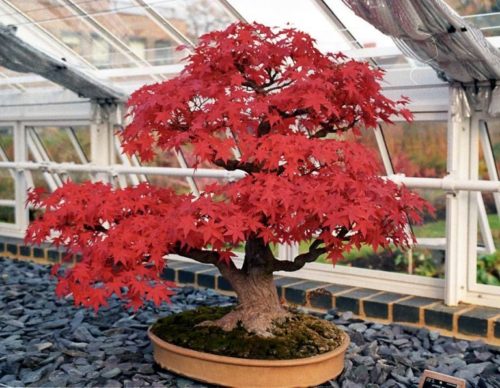
- Maple Ginnal is considered a valuable honey culture attracting bees and other insects during flowering. Maple honey contains about 2-3% sugar and 20-30% of tanning substances.
- In addition to decorative purposes, the maple is recognized as a medicinal plant. Most often, leaf beams, syrups and plant juice are used. But, without the recommendation of the doctor, it is not necessary to engage in self-medication, as this may lead to a deterioration of health.
- Also, the maple is classified as plants that are able to make a magical way to protect a person from the dark forces, to endow energy and power. It is believed that it is enough to lean against a tree and a person will feel the tide of strength, calm and sincere equilibrium.
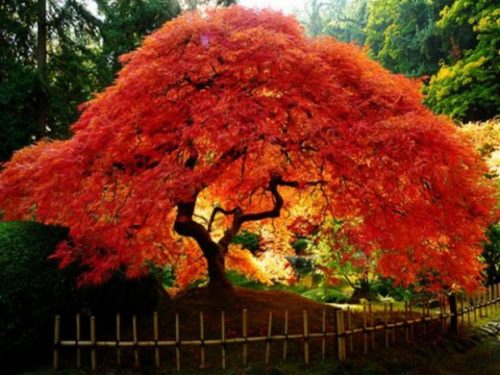
Thus, grow in the garden a picturesque plant - Maple Ginnal, absolutely simple. Properly planted in an open soil healthy maple seedlock is growing rapidly and develops in a new place.
Winter-hardy, light-headed, maple long-lived decorative almost all year round. The care for the perennial is minimal, but there will be a lot of bright impressions from a beautiful decorative tree!
Maple Ginnal, photo
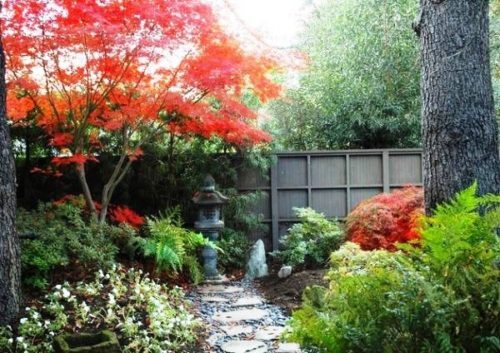

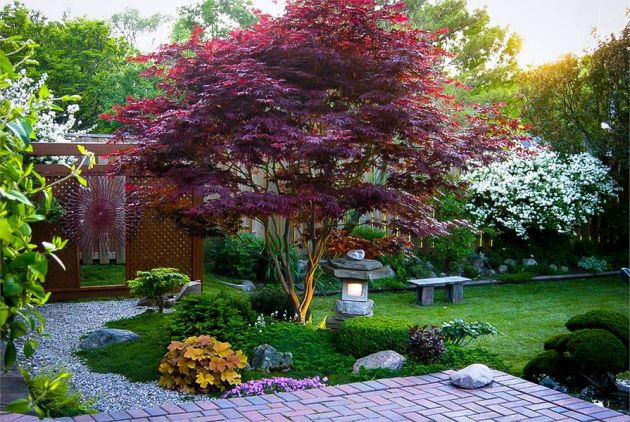
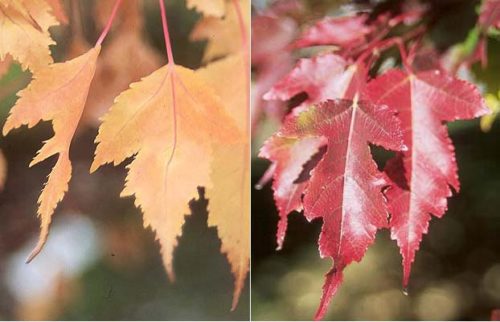
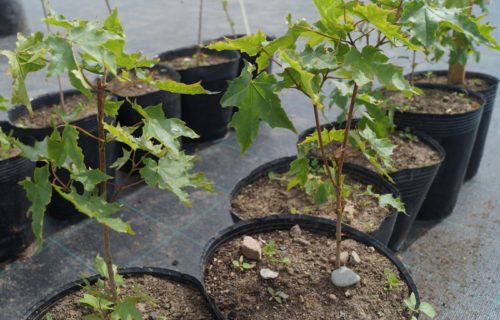
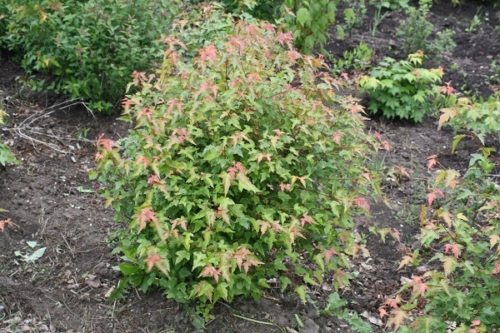
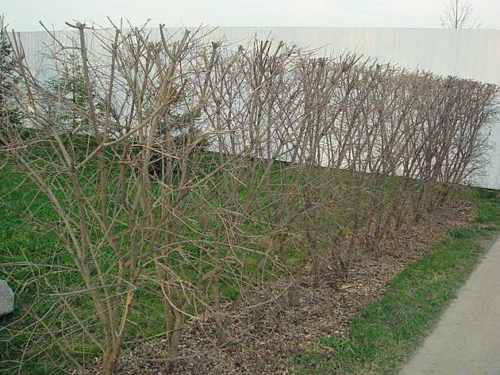
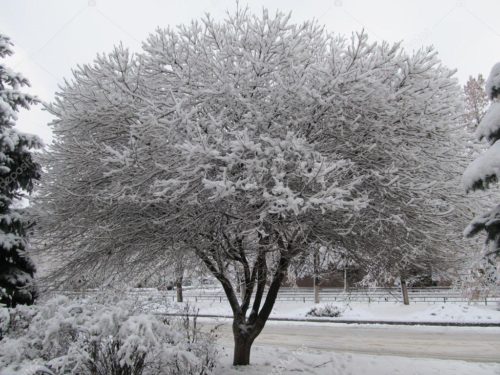
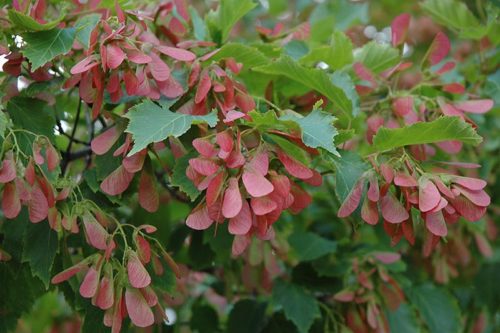
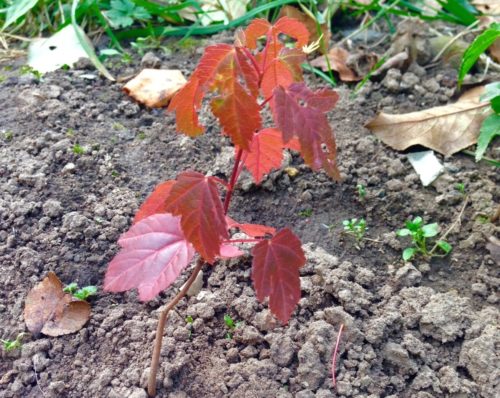
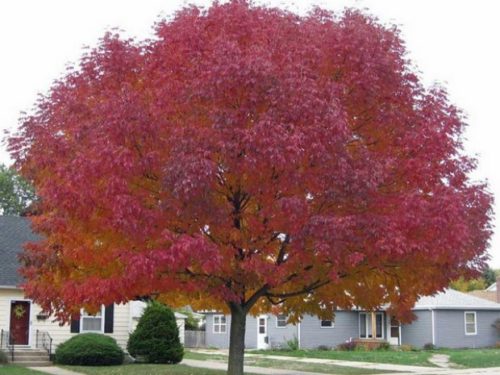
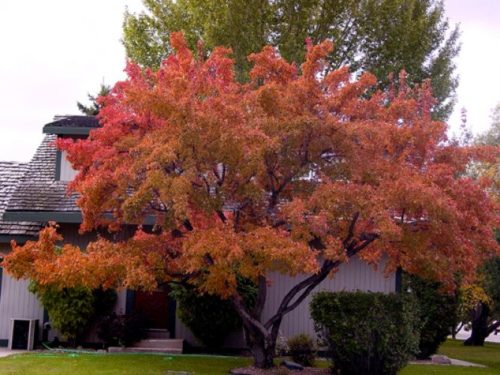
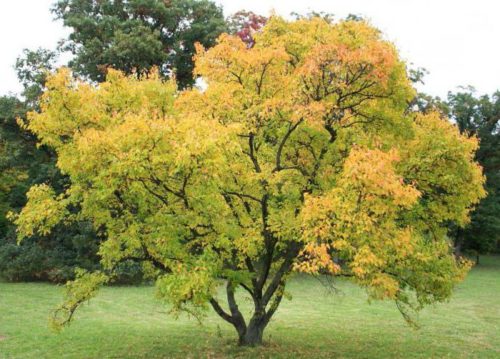
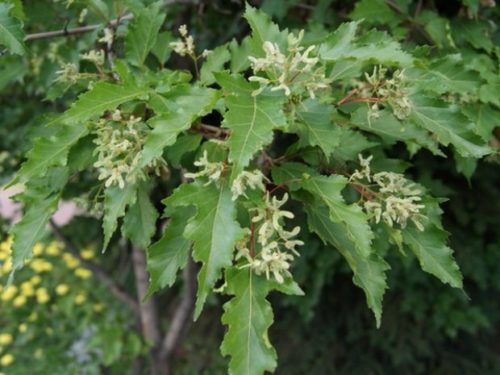












 Start a discussion ...
Start a discussion ...